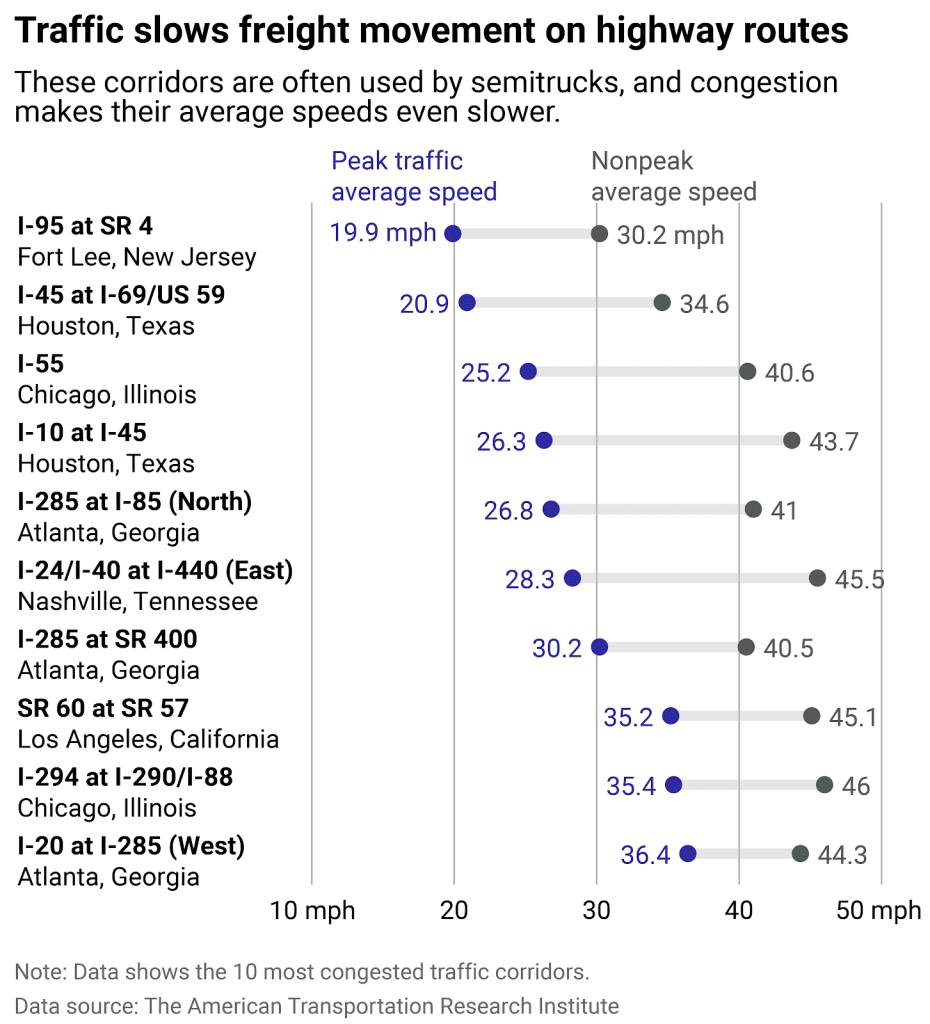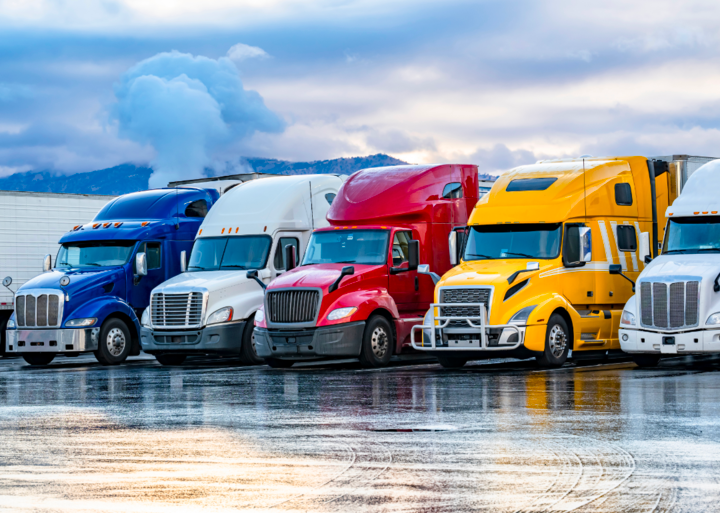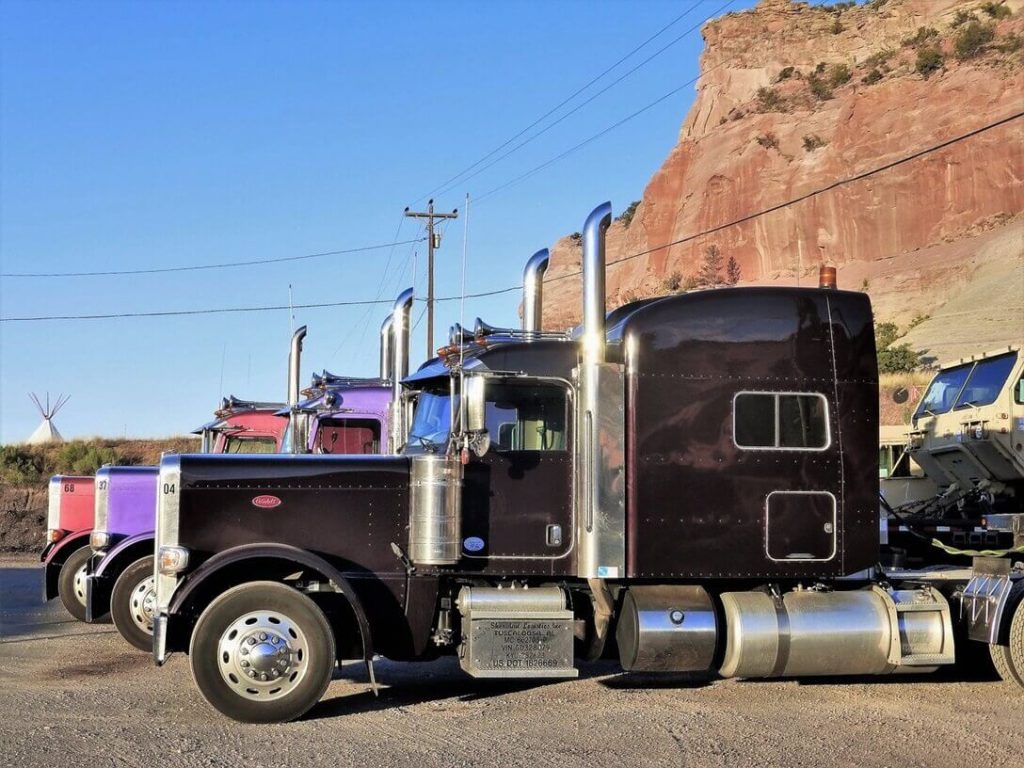
PARK YOUR TRAILER WITH NO HASSLE
Store your trailer in a safe place with a state-of-the-art platform that locates trailer parking near me.
The most congested freight corridors
Wondering why your packages are delayed, or perhaps why store inventory is low? The simple answer is these goods might be stuck in traffic. For example, the speed limit on Interstate 71 through Kentucky and Ohio is 70 mph, but the average speed for semitrucks is under 40 mph. Congestion around major metro areas can also create traffic backups that don’t just affect commuters but also the supply chain.
Companies rely heavily on the trucking industry to move goods around the country. In 2022, trucks carried nearly three-quarters of all freight in the U.S.—or 11.46 billion tons—according to the American Trucking Associations.
Unfortunately, ongoing highway congestion creates bottlenecks, which keep truck drivers from getting to where they need to go. Recurring bottlenecks happen for many reasons, including heavy traffic, construction, accidents, congestion at interchanges, and poorly timed traffic lights.
In their 2024 report, the American Transportation Research Institute found that trucks traveling along the country’s top 100 bottlenecks during peak hours hit an average speed of 34.4 mph, and if they had to drive through a top 10 bottleneck, speeds dropped to 28.5 mph. The problem’s not improving—83 of the top 100 bottlenecks reported peak traffic average speeds slower in 2023 than in 2022, making congestion worse.
Some traffic corridors are worse than others for freight drivers. Truck Parking Club used data from the ATRI to break down speeds on the 10 most congested freight corridors in the U.S. ATRI’s congestion value also considers the number of trucks that pass through each route on an hourly basis.
The struggle to get through traffic affects how much it costs to ship goods. In 2021, gridlock added $94.6 billion in labor, fuel, repair, and maintenance costs to the trucking industry, according to the ATRI. This included 1.27 billion hours lost to crawling down the highways—the equivalent of one work year for 460,000 truck drivers—and an extra 6.7 billion gallons of diesel fuel costing $22.3 billion.
Extra fuel usage also negatively impacts air quality. In 2016, ATRI researched the effect of congestion-related fuel usage on the environment. That year, the trucking industry used just 2% more fuel than it would in 2021—6.87 billion gallons—adding 67.3 million metric tons of carbon dioxide emissions to the atmosphere.Even short delays result in big costs. In 2019, UPS estimated that if every one of their trucks experienced a five-minute delay every day, it would cost the company $114 million each year. These costs generally get passed on to consumers.

FIND DAILY TRUCK PARKING IN NEARLY EVERY STATE
On the road and looking for a daily truck parking space? Find the closest daily parking spot in a matter of seconds.
Most congested corridors are concentrated around large cities
The bottleneck near the George Washington Bridge connecting New York City and New Jersey has had the country’s worst congestion for six consecutive years, thanks to high population numbers and demand for goods.
Houston also suffers from major congestion along I-10 and I-45. The I-10 corridor alone carries over $130 billion of goods a year, per Daily Commercial News. In 2024, the Texas Department of Transportation plans to break ground on a $9.7 billion improvement project to widen I-45 and reroute it around the Central Business District. This massive construction project should provide much-needed traffic improvements, but it won’t be completely finished until 2042.
Atlanta has several congestion hot spots, including fifth-place “Spaghetti Junction,” an interchange that connects four of the city’s biggest highways. Along with commuter traffic, truckers’ problems come from nearby trucking companies, a UPS distribution center, and the air cargo hub at Hartsfield-Jackson Atlanta International Airport.
The federal government is another major contributor to bottlenecks around the country, as the Infrastructure Investment and Jobs Act has created many construction sites on highways. For now, truck drivers can hold on to the hope that the short-term pain they currently feel while navigating around these work zones should turn into long-term gain as the completion of new roads and bridges improves traffic flow.
PREVIOUSLY INACCESSIBLE TRUCK PARKING
Take care of your truck and trailer parking needs with new locations added daily.
Written by Jill Jaracz. Story editing by Shannon Luders-Manuel. Copy editing by Tim Bruns.





